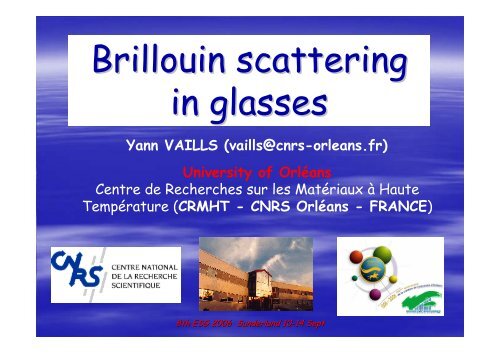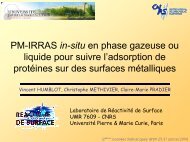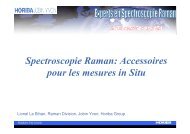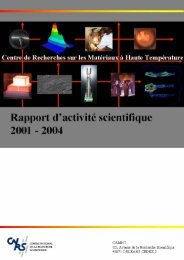Brillouin scattering in glasses
Brillouin scattering in glasses - Centre de recherche sur les ...
Brillouin scattering in glasses - Centre de recherche sur les ...
Create successful ePaper yourself
Turn your PDF publications into a flip-book with our unique Google optimized e-Paper software.
<strong>Brillou<strong>in</strong></strong> <strong>scatter<strong>in</strong>g</strong><strong>in</strong> <strong>glasses</strong>Yann VAILLS (vaills@cnrs-orleans.fr)University of OrléansCentre de Recherches sur les Matériaux à HauteTempérature (CRMHT - CNRS Orléans - FRANCE)8th ESG 2006 Sunderland 10-14 14 Sept
« La lumière est le pr<strong>in</strong>cipal personnage dans le tableau »(Light is the ma<strong>in</strong> subject of the picture)8th ESG 2006 Sunderland 10-14 14 SeptY. VAILLS – email : vaills@cnrs-orleans.frhttp://crmht.cnrs-orleans.fr/orleans.fr/pubcrmht/ext/peoplefile.aspx?nom=Vaills
I. Light <strong>scatter<strong>in</strong>g</strong>hν 0≈ 95 to 97%≈ 3 to 5%≈ 1%Scattered lightI scatt ∝ν 048th ESG 2006 Sunderland 10-14 14 SeptY. VAILLS – email : vaills@cnrs-orleans.frhttp://crmht.cnrs-orleans.fr/orleans.fr/pubcrmht/ext/peoplefile.aspx?nom=Vaills
8th ESG 2006 Sunderland 10-14 14 SeptY. VAILLS – email : vaills@cnrs-orleans.frhttp://crmht.cnrs-orleans.fr/orleans.fr/pubcrmht/ext/peoplefile.aspx?nom=Vaills
8th ESG 2006 Sunderland 10-14 14 SeptY. VAILLS – email : vaills@cnrs-orleans.frhttp://crmht.cnrs-orleans.fr/orleans.fr/pubcrmht/ext/peoplefile.aspx?nom=Vaills
hν 0Scattered light :I scatt = I(ν 0 ) + I(ν≠ν 0 )≈ 90 to 99 %Rayleigh <strong>scatter<strong>in</strong>g</strong>≈ 1 to 10%Raman effect8th ESG 2006 Sunderland 10-14 14 SeptY. VAILLS – email : vaills@cnrs-orleans.frhttp://crmht.cnrs-orleans.fr/orleans.fr/pubcrmht/ext/peoplefile.aspx?nom=Vaills
Vibrational spectroscopies• <strong>Brillou<strong>in</strong></strong> <strong>scatter<strong>in</strong>g</strong>• Raman <strong>scatter<strong>in</strong>g</strong>• Infrared spectroscopy8th ESG 2006 Sunderland 10-14 14 SeptY. VAILLS – email : vaills@cnrs-orleans.frhttp://crmht.cnrs-orleans.fr/orleans.fr/pubcrmht/ext/peoplefile.aspx?nom=Vaills
II. The Raman effectI scatt = I Rayl (ν 0 ) + I Raman (ν)ν Raman = ν 0 ± ν iν 0 : <strong>in</strong>cident light frequencyν i : i vibrational mode frequency8th ESG 2006 Sunderland 10-14 14 SeptY. VAILLS – email : vaills@cnrs-orleans.frhttp://crmht.cnrs-orleans.fr/orleans.fr/pubcrmht/ext/peoplefile.aspx?nom=Vaills
• Scatter<strong>in</strong>g by vibrational modes :k r<strong>in</strong>ck r<strong>in</strong>ck rscattq rk rscattq rantistokesAnnihilation of avibrational modeν s = ν 0 + ν phononrq≅r rk <strong>in</strong>c ≅ k scattcreation of avibrational modeν s = ν 0 - ν phononstokes8th ESG 2006 Sunderland 10-14 14 SeptY. VAILLS – email : vaills@cnrs-orleans.frhttp://crmht.cnrs-orleans.fr/orleans.fr/pubcrmht/ext/peoplefile.aspx?nom=Vaills
RAMAN <strong>scatter<strong>in</strong>g</strong>ExitedelectroniclevelsRAYLEIGH<strong>scatter<strong>in</strong>g</strong>StokesAntistokesVirtual levelshν 0hν 0hν 1 hν 0Fondamentalelectronic level8th ESG 2006 Sunderland 10-14 14 SeptY. VAILLS – email : vaills@cnrs-orleans.frhttp://crmht.cnrs-orleans.fr/orleans.fr/pubcrmht/ext/peoplefile.aspx?nom=VaillsVibrational levelsMaxwell – Boltzmann ⇒ Raman Stokes et anti-Stokes l<strong>in</strong>es havenot the same <strong>in</strong>tensities
Scattered <strong>in</strong>tensityRayleighν 1 = ν 0 - 459 cm -1ν 2 = ν 0 - 314 cm -1ν 3 = ν 0 - 218 cm -1Ramanν 4 = ν 0 + 218 cm -1ν 5 = ν 0 + 314 cm -1ν 6 = ν 0 + 459 cm -1CCl 4Raman spectrum at room temperature8th ESG 2006 Sunderland 10-14 14 SeptY. VAILLS – email : vaills@cnrs-orleans.frhttp://crmht.cnrs-orleans.fr/orleans.fr/pubcrmht/ext/peoplefile.aspx?nom=Vaills
Intensity (a.u.)1,210,80,60,40,20Raman spectrum of the glass (SiO 2 ) 82 (K 2 0) 180 500 1000 1500 2000frequency shift (cm -1 )Exp.Raman8th ESG 2006 Sunderland 10-14 14 SeptY. VAILLS – email : vaills@cnrs-orleans.frhttp://crmht.cnrs-orleans.fr/orleans.fr/pubcrmht/ext/peoplefile.aspx?nom=Vaills
III. The different types of light<strong>scatter<strong>in</strong>g</strong>• Rayleigh <strong>scatter<strong>in</strong>g</strong>• Raman <strong>scatter<strong>in</strong>g</strong>• <strong>Brillou<strong>in</strong></strong> <strong>scatter<strong>in</strong>g</strong>8th ESG 2006 Sunderland 10-14 14 SeptY. VAILLS – email : vaills@cnrs-orleans.frhttp://crmht.cnrs-orleans.fr/orleans.fr/pubcrmht/ext/peoplefile.aspx?nom=Vaills
• Scatter<strong>in</strong>g by density <strong>in</strong>homogeneities :Rayleigh <strong>scatter<strong>in</strong>g</strong> (static(static)<strong>Brillou<strong>in</strong></strong> <strong>scatter<strong>in</strong>g</strong> (dynamic(dynamic)Iid=⎛ 8I ⎜π0⎝ 3 λ034⎞⎟⎠n8⎛ β⎜⎝ ρid⎞⎟⎠2Δρ2V0k TJ. Shroeder JACS 1973 ; K. Saito APL 1997B2Δρ• Static fluctuations : structural or chemical fluctuations• Dynamical fluctuations : acoustical modes of vibration8th ESG 2006 Sunderland 10-14 14 SeptY. VAILLS – email : vaills@cnrs-orleans.frhttp://crmht.cnrs-orleans.fr/orleans.fr/pubcrmht/ext/peoplefile.aspx?nom=Vaills
Rayleigh <strong>scatter<strong>in</strong>g</strong> : due to the staticfluctuations of refractive <strong>in</strong>dex8th ESG 2006 Sunderland 10-14 14 SeptY. VAILLS – email : vaills@cnrs-orleans.frhttp://crmht.cnrs-orleans.fr/orleans.fr/pubcrmht/ext/peoplefile.aspx?nom=Vaills
The case of a diatomic l<strong>in</strong>ear lattice, periodicity : arq≅rk<strong>in</strong>c≅rkscatt≅2 π
IV. <strong>Brillou<strong>in</strong></strong> and Rayleigh <strong>scatter<strong>in</strong>g</strong><strong>Brillou<strong>in</strong></strong> spectrum of the glass (SiO 2 ) 85 (K 2 O) 15Rayleigh l<strong>in</strong>e <strong>Brillou<strong>in</strong></strong> longitud<strong>in</strong>al l<strong>in</strong>e6543<strong>Brillou<strong>in</strong></strong> transverse l<strong>in</strong>e210-0,1 0 0,1 0,2 0,3 0,4 0,5 0,6 0,7 0,8 0,9Frequency shift (cm -1 )8th ESG 2006 Sunderland 10-14 14 SeptY. VAILLS – email : vaills@cnrs-orleans.frhttp://crmht.cnrs-orleans.fr/orleans.fr/pubcrmht/ext/peoplefile.aspx?nom=VaillsIntensity (arbitrary unit)
• 1. L<strong>in</strong>es frequenciesFor a right <strong>scatter<strong>in</strong>g</strong> configurationr rk <strong>in</strong>c ⊥ k scattν0 0 2 C11ν l = n 2Vl= nνc00 44νt= n 2Vt= ncνcνcρ2 CρLongitud<strong>in</strong>al acoustic mode of vibrationTransverse acoustic mode of vibration8th ESG 2006 Sunderland 10-14 14 SeptY. VAILLS – email : vaills@cnrs-orleans.frhttp://crmht.cnrs-orleans.fr/orleans.fr/pubcrmht/ext/peoplefile.aspx?nom=Vaills
• From the <strong>Brillou<strong>in</strong></strong> frequencies we deduceThe elastic properties of materials(see for example A.K. Varshneya 2006, or Y. Vaills web page)• n and ρ : measured by classical methods• <strong>in</strong> an isotrope material : 2 <strong>in</strong>dependent elastic constants<strong>Brillou<strong>in</strong></strong> <strong>scatter<strong>in</strong>g</strong> ν l νt⇒ C 11 and C 44C 12 = C 11 –2C 441λ = C 12μ = C 44Lame’s constantsEχ =σp=μ(3 λ + 2 μ )λ + μ3 −=3 λ + 2 μλ=2 ( μ + λ )KYoung’s moduluscompressibilityPoisson ratio8th ESG 2006 Sunderland 10-14 14 SeptY. VAILLS – email : vaills@cnrs-orleans.frhttp://crmht.cnrs-orleans.fr/orleans.fr/pubcrmht/ext/peoplefile.aspx?nom=Vaills
• 2. L<strong>in</strong>es <strong>in</strong>tensitiesScatter<strong>in</strong>g by density fluctuations :Rayleigh<strong>scatter<strong>in</strong>g</strong> (static)<strong>Brillou<strong>in</strong></strong> <strong>scatter<strong>in</strong>g</strong> (dynamic)Freez<strong>in</strong>g ofdensityfluctuationsat the glasstransitionIid=⎛ 8I ⎜π0⎝ 3 λ034⎞⎟⎠n8⎛ β⎜⎝ ρid⎞⎟⎠2Δρ2V0k TJ. Shroeder JACS 1973 ; K. Saito APL 1997BT > T gIid=⎛ 8I ⎜π0⎝ 3 λ034⎞⎟⎠n8β2idχT(T ) k TB8th ESG 2006 Sunderland 10-14 14 SeptY. VAILLS – email : vaills@cnrs-orleans.frhttp://crmht.cnrs-orleans.fr/orleans.fr/pubcrmht/ext/peoplefile.aspx?nom=Vaills
T < TgIid⎛38 ⎞I ⎜π 8 2= ⎟0n4 id T ,rel g B g3βχ⎝ λ0⎠[ χ (T ) k T + (T ) k T ]S , ∞BRayleigh <strong>scatter<strong>in</strong>g</strong> :- static density <strong>in</strong>homogeneities(elastic <strong>scatter<strong>in</strong>g</strong>)- Incoherent atoms motions,non propagat<strong>in</strong>g excitations(quasielastic <strong>scatter<strong>in</strong>g</strong>)(R. Vacher JCP 1985)(J. Shroeder JACS 1973)<strong>Brillou<strong>in</strong></strong> <strong>scatter<strong>in</strong>g</strong> : <strong>in</strong>elastic <strong>scatter<strong>in</strong>g</strong>(dynamic density fluctuations : mechanical waves)8th ESG 2006 Sunderland 10-14 14 SeptY. VAILLS – email : vaills@cnrs-orleans.frhttp://crmht.cnrs-orleans.fr/orleans.fr/pubcrmht/ext/peoplefile.aspx?nom=Vaills
• Landau-PlaczekratioR =L −PIR/2 IB LIn a viscoelastic material :(N. Laberge JACS 1973)IRayleigh∝Δρ2kν = 0=( ρ20/ V ) k T [( χBT−χS) +χrS]Isobaric-entropy fluctuationsFluctuation associated withstructural variations<strong>in</strong> adiabatic-pressure fluctuations⇔ relaxational compressibility8th ESG 2006 Sunderland 10-14 14 SeptY. VAILLS – email : vaills@cnrs-orleans.frhttp://crmht.cnrs-orleans.fr/orleans.fr/pubcrmht/ext/peoplefile.aspx?nom=Vaills
After quench<strong>in</strong>g fluctuations are frozen<strong>in</strong>to the material at the equilibriumstructural configuration correspond<strong>in</strong>g tothe fictive temperature T f(N. Laberge JACS 1973)I22−1Rayleigh∝ Δρk= ( ρ0/ V ) kBTf[( χT− χS) + ( χS− Cν = 011)]I<strong>Brillou<strong>in</strong></strong>∝Δρ2kν ≠0=(ρ20/ V )[ k TCB−111]8th ESG 2006 Sunderland 10-14 14 SeptY. VAILLS – email : vaills@cnrs-orleans.frhttp://crmht.cnrs-orleans.fr/orleans.fr/pubcrmht/ext/peoplefile.aspx?nom=Vaills
⇒ Determ<strong>in</strong>ation of a glass fictive temperatureRL −P=TfT( C χ − 1)11TDirectly deduced from by <strong>Brillou<strong>in</strong></strong> <strong>scatter<strong>in</strong>g</strong>8th ESG 2006 Sunderland 10-14 14 SeptY. VAILLS – email : vaills@cnrs-orleans.frhttp://crmht.cnrs-orleans.fr/orleans.fr/pubcrmht/ext/peoplefile.aspx?nom=Vaills
Influence of heat treatment on silica for optical fiberY. Vaills (CRMHT), P. Simon (CRMHT), G. Matzen (CRMHT),H. Cattey (post-doc CRMHT-Alcatel), G. Orcel (Alcatel)Effect of fictive de la temperatureon light <strong>scatter<strong>in</strong>g</strong> <strong>in</strong> silica-110 -29 I(T) sec30 SiOnucléation220100500 1000 1500 T 2000 (K)Rapport Landau-Placzek: R LP3634323028Nucleation effect1400 1500 1600 1700 1800T de recuit (K)Effect of fictivetemperatureRL −PTf=T( C χ − 1)11T8th ESG 2006 Sunderland 10-14 14 SeptY. VAILLS – email : vaills@cnrs-orleans.frhttp://crmht.cnrs-orleans.fr/orleans.fr/pubcrmht/ext/peoplefile.aspx?nom=Vaills
• From the <strong>Brillou<strong>in</strong></strong> l<strong>in</strong>e <strong>in</strong>tensities we deduce• The photoelastic constants of the materialsCoupl<strong>in</strong>g between elastic waves andelectromagnetic waves• electromagnetic energy loss <strong>in</strong> materialsAttenuation of electromagnetic wave <strong>in</strong>optical fibers• fictive temperature of <strong>glasses</strong>8th ESG 2006 Sunderland 10-14 14 SeptY. VAILLS – email : vaills@cnrs-orleans.frhttp://crmht.cnrs-orleans.fr/orleans.fr/pubcrmht/ext/peoplefile.aspx?nom=Vaills
• 3. L<strong>in</strong>es shapes(See for example R. Vacher JCP 1985, J. Schreoder JNCS 1988)The experimental <strong>Brillou<strong>in</strong></strong> l<strong>in</strong>e is :a convolution of the natural <strong>Brillou<strong>in</strong></strong> l<strong>in</strong>e with the apparatus function• natural <strong>Brillou<strong>in</strong></strong> l<strong>in</strong>e :• apparatus function :narrow lorentzian shapea convolution of several contributions- The f<strong>in</strong>ite frequency width of the laser- The f<strong>in</strong>ite acceptance angle of the light gather<strong>in</strong>g- The Airy’s transmission function of the F-P <strong>in</strong>terferometer8th ESG 2006 Sunderland 10-14 14 SeptY. VAILLS – email : vaills@cnrs-orleans.frhttp://crmht.cnrs-orleans.fr/orleans.fr/pubcrmht/ext/peoplefile.aspx?nom=Vaills
• Extraction of the natural <strong>Brillou<strong>in</strong></strong> l<strong>in</strong>e :deconvolution of the spectrum : several technicsFor example :I(H.W. Leidecker J.A.S.A. 1967D. Walton S.S.C. 1982G.E. Durand IEEE J.Q.E.1968A.S. P<strong>in</strong>e PR 1969)exp<strong>Brillou<strong>in</strong></strong>( ν ) = Snat( ν ) ∗ Iapp( ν )LorentzianGaussian8th ESG 2006 Sunderland 10-14 14 SeptY. VAILLS – email : vaills@cnrs-orleans.frhttp://crmht.cnrs-orleans.fr/orleans.fr/pubcrmht/ext/peoplefile.aspx?nom=Vaills
Experimental <strong>Brillou<strong>in</strong></strong> l<strong>in</strong>ewidth : convolution of- Natural <strong>Brillou<strong>in</strong></strong> l<strong>in</strong>ewidth ΔΓ B (≈ 0.1 GHz)- Instrumental l<strong>in</strong>ewidth (≈ 1 GHz)Phonon liftime τ :τ = 1ΔΓ BPhonon attenuation coefficient α :ΔΓB =αVlπ8th ESG 2006 Sunderland 10-14 14 SeptY. VAILLS – email : vaills@cnrs-orleans.frhttp://crmht.cnrs-orleans.fr/orleans.fr/pubcrmht/ext/peoplefile.aspx?nom=Vaills
• From the <strong>Brillou<strong>in</strong></strong> l<strong>in</strong>e shapes we deduce• Structural <strong>in</strong>formations via the lifetimeof vibrational waves• Characterization of relaxation phenomenonsbonded to rearrangements of the structure• Properties controlled by vibrational wavesThermal expansion coefficient and its anomaliesThermal expansion coefficient and its anomaliesAnharmonicity(R. Vacher ,communication at this Conference 8 th ESG 2006, and PRB 2005)8th ESG 2006 Sunderland 10-14 14 SeptY. VAILLS – email : vaills@cnrs-orleans.frhttp://crmht.cnrs-orleans.fr/orleans.fr/pubcrmht/ext/peoplefile.aspx?nom=Vaills
V. <strong>Brillou<strong>in</strong></strong> <strong>scatter<strong>in</strong>g</strong> apparatussampleFabry-PérotMichelsonInterferential FilterPMPressure scannedFabry-PérotSlice λ/2PumpGas (Freon)AmplifierSynchrone detectionshopperLaserAr-514.5nmAcquisition8th ESG 2006 Sunderland 10-14 14 SeptY. VAILLS – email : vaills@cnrs-orleans.frhttp://crmht.cnrs-orleans.fr/orleans.fr/pubcrmht/ext/peoplefile.aspx?nom=Vaills
sampleTandempiezoelectricallyscannedFabry-PérotSlice eλ/2PMJ.R. SandercockAmplifierSynchrone detectionshopperLaserAr-514.5nmAcquisition8th ESG 2006 Sunderland 10-14 14 SeptY. VAILLS – email : vaills@cnrs-orleans.frFigure II.9 http://crmht.cnrs-orleans.fr/: Schéma du dispositif orleans.fr/pubcrmhtexpérimental pubcrmht/ext pour l’étude ext/peoplefile.aspx?nom=Vaillsde la diffusion <strong>Brillou<strong>in</strong></strong>
Comparison of the two devicesLow RamanfrequenciesTriple passed pressurescanned Pérot-FabryTandem Triple passedFPpiezo-elel ly controlledContrast 3 10 6 10F<strong>in</strong>esse 70 8010 11Instrumental l<strong>in</strong>ewidthResolutionAccessiblefrequency rangeAcquisition timefor 1 scan770 MHz 500 MHz770 MHz at e = 2.76 mmR = 760 0005 - 50 GHz0,2 - 2 cm -1500 MHz at e = 2 mmR = 1 170 0005 - 1500 THz0,2 - 500 cm -145 m<strong>in</strong>utes for 4 cm -1 30 seconds for 500 cm -1Spectra accumulations Impossible Possible8th ESG 2006 Sunderland 10-14 14 SeptY. VAILLS – email : vaills@cnrs-orleans.frhttp://crmht.cnrs-orleans.fr/orleans.fr/pubcrmht/ext/peoplefile.aspx?nom=Vaills
VI. <strong>Brillou<strong>in</strong></strong> <strong>scatter<strong>in</strong>g</strong> <strong>in</strong> <strong>glasses</strong>• Localisation of residual stresses <strong>in</strong>silicate b<strong>in</strong>ary <strong>glasses</strong> (SiO 2 ) 1-x (Na 2 O) x0,0100,0 0,1 0,2 0,3 0,4ρ(annealed)-ρ(non-annealed)(Y. Vaills JNCS 2001)Δρ(g/cm 3 )0,0080,0060,0040,0020,000-0,0020,0 0,1 0,2 0,3 0,4molar fraction of Na 2 O : x8th ESG 2006 Sunderland 10-14 14 SeptY. VAILLS – email : vaills@cnrs-orleans.frhttp://crmht.cnrs-orleans.fr/orleans.fr/pubcrmht/ext/peoplefile.aspx?nom=Vaills
• Localisation of residual stresses <strong>in</strong>silicate b<strong>in</strong>ary <strong>glasses</strong> (SiO 2 ) 1-x (Na 2 O) xHypotheses for calculation of elasticenergy• 1) We have considered that the variations of Na-O length could be the unique cause of the densitychange on anneal<strong>in</strong>g.• 2) Consequently, most of the elastic energy dueto residual stress before anneal<strong>in</strong>g is located <strong>in</strong>the sodium atoms neighbourhood.8th ESG 2006 Sunderland 10-14 14 SeptY. VAILLS – email : vaills@cnrs-orleans.frhttp://crmht.cnrs-orleans.fr/orleans.fr/pubcrmht/ext/peoplefile.aspx?nom=Vaills
• Localisation of residual stresses <strong>in</strong>silicate b<strong>in</strong>ary <strong>glasses</strong> (SiO 2 ) 1-x (Na 2 O) x• 3) In order to simplify the evaluation of thedeformation tensor we suppose that theresidual stresses are of hydrostatic type. Thenthe relative dilatation can be calculated fromthe relative variation of the density :θ = −Δρρ• 4) We neglect the variations of <strong>in</strong>teratomicbond strengths <strong>in</strong>duced by the <strong>in</strong>teratomic bondlength variations.8th ESG 2006 Sunderland 10-14 14 SeptY. VAILLS – email : vaills@cnrs-orleans.frhttp://crmht.cnrs-orleans.fr/orleans.fr/pubcrmht/ext/peoplefile.aspx?nom=Vaills
• Localisation of residual stresses <strong>in</strong>silicate b<strong>in</strong>ary <strong>glasses</strong> (SiO 2 ) 1-x (Na 2 O) xConsequently the elastic energy stored <strong>in</strong> thenon-annealed glass is given by :2Φ = θ6( 3C11− 4C44)Φ is the elastic energy per unit of volume, C 11 andC 44 are the elastic constants of the annealedglass (undeformed glass).8th ESG 2006 Sunderland 10-14 14 SeptY. VAILLS – email : vaills@cnrs-orleans.frhttp://crmht.cnrs-orleans.fr/orleans.fr/pubcrmht/ext/peoplefile.aspx?nom=Vaills
• Localisation of residual stresses <strong>in</strong>silicate b<strong>in</strong>ary <strong>glasses</strong> (SiO 2 ) 1-x (Na 2 O) x(J/m 3 )3,5x10 53,0x10 5elastic energy2,5x10 52,0x10 51,5x10 51,0x10 55,0x10 40,0-5,0x10 40,0 0,1 0,2 0,3 0,4mol. fract. of Na 2 O8th ESG 2006 Sunderland 10-14 14 SeptY. VAILLS – email : vaills@cnrs-orleans.frhttp://crmht.cnrs-orleans.fr/orleans.fr/pubcrmht/ext/peoplefile.aspx?nom=Vaills
• Localisation of residual stresses <strong>in</strong>silicate b<strong>in</strong>ary <strong>glasses</strong> (SiO 2 ) 1-x (Na 2 O) x• If we write the total volume of the glass as :3V = VNa−O+ VSiO= nαa +• where a = r Na-O , then we can calculate δathrough anneal<strong>in</strong>g by :2VSiO2δ a =−Δ ρ V2ρ n α 3a8th ESG 2006 Sunderland 10-14 14 SeptY. VAILLS – email : vaills@cnrs-orleans.frhttp://crmht.cnrs-orleans.fr/orleans.fr/pubcrmht/ext/peoplefile.aspx?nom=Vaills
• Localisation of residual stresses <strong>in</strong>silicate b<strong>in</strong>ary <strong>glasses</strong> (SiO 2 ) 1-x (Na 2 O) xUs<strong>in</strong>g•the δ(r Na-O ),• the elastic energy variations through anneal<strong>in</strong>g• and the fact that Na is known to be fivefold coord<strong>in</strong>ated<strong>in</strong> Na 2 O-SiO 2 <strong>glasses</strong>,we calculated :1) the elastic energy for each Na-O pair2) the force constant of Na-O bond3) the frequency associated to the Na vibrational mode8th ESG 2006 Sunderland 10-14 14 SeptY. VAILLS – email : vaills@cnrs-orleans.frhttp://crmht.cnrs-orleans.fr/orleans.fr/pubcrmht/ext/peoplefile.aspx?nom=Vaills
• Localisation of residual stresses <strong>in</strong>silicate b<strong>in</strong>ary <strong>glasses</strong> (SiO 2 ) 1-x (Na 2 O) x(cm -1 )24020016012080IR frequencies-1ν = 1/2π[k(m +(5mONa) -1 )] 1/2-1ν = 1/2π[k(m +(6mONa) -1 )] 1/2ν = 1/2π[k/mNa] 1/2400,0 0,1 0,2 0,3 0,4 0,5molar fraction of Na 2 O : x8th ESG 2006 Sunderland 10-14 14 SeptY. VAILLS – email : vaills@cnrs-orleans.frhttp://crmht.cnrs-orleans.fr/orleans.fr/pubcrmht/ext/peoplefile.aspx?nom=Vaills
constra<strong>in</strong>t theory(J.C. Phillips JNCS 1979)B<strong>in</strong>ary <strong>glasses</strong> (SiO 2 ) 1-x (Na 2 O) xSiONaNa <strong>in</strong>creases ⇒connectedness decreasesQ 3n c= 2.67Q 4n c= 3.67X c = 0.28th ESG 2006 Sunderland 10-14 14 SeptY. VAILLS – email : vaills@cnrs-orleans.frhttp://crmht.cnrs-orleans.fr/orleans.fr/pubcrmht/ext/peoplefile.aspx?nom=Vaillsn c =⇓3x = x c Elastic phasetransition from rigid tofloppy phase
Unsteady state and elastic free energythrow anneal<strong>in</strong>g : ΔΦ(Vaills J. Phys. C 2005)ΔΦ=1 ⎛ Δρ ⎞⎜ ⎟6 ⎝ ρ ⎠2( 3C − 4C )1144Random networks with<strong>in</strong> meanfieldtheory : f(x)= (10x-3)/3floppy modesx = 0.238x < 0.2 ⇒ 0 floppy modesx > 0.2 ⇒ ΔΦparallels f(x)Floppy modes fraction f(x)8th ESG 2006 Sunderland 10-14 14 SeptY. VAILLS – email : vaills@cnrs-orleans.frhttp://crmht.cnrs-orleans.fr/orleans.fr/pubcrmht/ext/peoplefile.aspx?nom=VaillsIn amorphous silica d 2 ΔΦ/dx 2 :Cusp at x = 0.211(Thorpe JNCS 2000)
References :• THE RAMAN EFFECT, a unified treatment of the theory of Raman <strong>scatter<strong>in</strong>g</strong> by molecules , Derek A. Long,Wiley 2002• Infrared and Raman Spectroscopy, Mehtods and Applications, Edited d by B. SchraderVCH, 1995• Durand G.E. et al, IEEE, J. Quant. Electron. 4 (1968) 523• Laberge N. L., et al J. of the Am. Ceram. Soc. 56 (1973) 506-509509• Leidecker H.W. et al J. Acoustic Soc. Am. 43 (1967), 737• Malki M. Et al Phys. Rev. Lett. 96 (2006) 145504• P<strong>in</strong>e A.S. Phys. Rev. 185 (1969) 1187• Phillips J.C. - J. of Non-Crystall<strong>in</strong>e Solids 34 (1979), 153-181181• Saito K. et al A. J. App. Phys. Lett. 70 (1997) 3504-35063506• Schroeder J., et al J. of the Am. Ceram. Soc. 56 (1973) 510-514514• Schroeder J., et al J. of Non-Crystall<strong>in</strong>e Solids 40 (1980) 549-566.566.• Schroeder J. J. of Non-Crystall<strong>in</strong>e Solids 102 (1988) 240-249249• Thorpe M.F. - JNCS 859 (2000), 266-269269• Vacher R. et al J. de Chimie Physique 82 (1985), 311-316316• Vacher R. et al Phys. Rev. B 72, , (2005), 214205• Vaills Y. et al JNCS 286, , (2001), 224-234234• Vaills et al J. of Physics C 17 (2005), 4889-48964896• Vaills Y. web page : http://crmht.cnrs-orleans.fr/pubcrmht/ext/peoplefile.aspx?nom=Vaills• Varshneya A.K. Fundamentals of <strong>in</strong>organic <strong>glasses</strong>, Soc. Of Glass Tech., 200606• Walton D. et al, Sol. St. Comm. 42 (1982), 7378th ESG 2006 Sunderland 10-14 14 SeptY. VAILLS – email : vaills@cnrs-orleans.frhttp://crmht.cnrs-orleans.fr/orleans.fr/pubcrmht/ext/peoplefile.aspx?nom=Vaills






